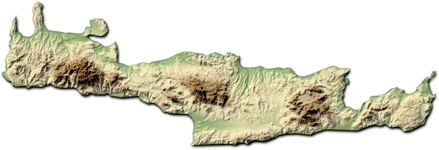
|
Folk Dance Federation of California, South, Inc.
|

|
CLICK AN IMAGE TO ENLARGE
 It is generally accepted that the dance syrtos from Crete is known as Haniotikos because it was once danced mostly in the provinces and districts of the nomos (county) of Hania where it has been said to have been "perfected." Today it is pan-Cretan and natives refer to it simply as syrtos, wheras most other Greeks use the adjective Kritikos (Cretan) or Haniotikos. American folk dancers tend to use Kritikos and rarely use the term Haniotikos.
It is generally accepted that the dance syrtos from Crete is known as Haniotikos because it was once danced mostly in the provinces and districts of the nomos (county) of Hania where it has been said to have been "perfected." Today it is pan-Cretan and natives refer to it simply as syrtos, wheras most other Greeks use the adjective Kritikos (Cretan) or Haniotikos. American folk dancers tend to use Kritikos and rarely use the term Haniotikos.
Cretans, when placing a request for a specific syrtos, seldom mention the word; they usually ask the lyraris (lyra player) for the title of a syrtos, i.e., a Rodhinou (a composition by the famous lyrari Rodhinos) or the protos (first, original – a specific old melody well known to all Cretans and considered to be the old "original" syrtos) or a Seliniotikos (a composition by someone in or from the town of Selinos), etc.
No one is excluded from doing the syrtos. In Crete, however, a strict protocol is followed. Only the leader and the second person in the line dance; the others simply walk along. After an appropriate length of time, the second person relinquishes his position to the third person and goes to the end of the line. Thus, the lead dancer personally "dances" with everyone in line while the second dancer's obligation is to maintain the dance pattern. In the U.S. this is rarely seen, occurring only at purly Cretan events and mostly with an all male line. Sometimes the composition of the line varies: 1) a mixed group with a male leader or 2) a line of women with a male leader. Very, very rare is a woman a leader who "dances" with others.
At weddings, especially in the U.S., the syrtos is used as the "bridal" dance. Everyone, from closest family members to those outside the extended family, take their turn "dancing" the bride.
Occasionally at a panegyris (an ancient Greek general, national or religious assembly) or taverna musicians will play for general dancing. Ordinarily the dancing floor is reserved for individual parees ("parties" or "tables" of friends) who request and pay for a particular dance and oftentimes a specific piece of music. Any one party can dance for any length of time, usually determined by the number of people in the party. One syrtos can last longer than thirty minutes.
By far, the most frequently performed dance during any Cretan festivity is the syrtos; it is done at least twice as often as the sum total of the other Cretan dances pentozalis, sousta, and kastrinos/maleviziotikos/pidikhtos ("leaping dances), and at least twice as long, mainly because the latter are too exerting and cannot be sustained for long. Usually every parea (to be in the company of friends or to do something together) will begin dancing with a syrtos. One of the three "leaping" dances will follow a syrtos but rarely will one "leaping" dance follow another. When this does happen the second dance will probably be the less strenuous couple dance sousta.
In Crete it seems that a new crop of musicians appears every few years, which makes dancing to live music customary and expected. In Irakleion one can dance any night of the week at a taverna; in Hania, several nights a week. The villager who today has good mobility, can, on the average, attend a dance event once a week either at the nearby city or town as well as at the rural panegyris, which, for instance in nomos (law or custom) Hania, occurs with great frequency during summer and fall. In the U.S. we are not so fortunate; we can dance to live Cretan music only once a year at the annual Cretan affair.
From the 1981 AMAN Institute syllabus.